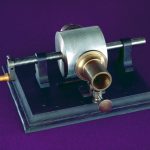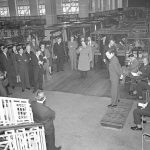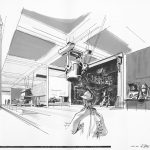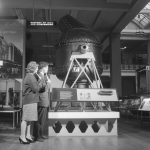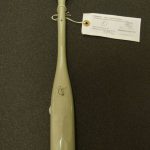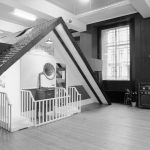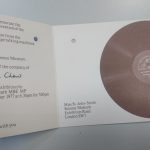Acoustics on display: collecting and curating sound at the Science Museum
Article DOI: https://dx.doi.org/10.15180/170706
Abstract
This article traces sound as it echoes through approaches to displaying the Science Museum’s acoustics collection over the course of the twentieth century. Focusing on three key moments in the collection’s historical development, the article explores the role of sound as both medium and object of museum display. Each moment exposes how the practice of using sound to interpret sounding objects was articulated and problematised by past generations of museum practitioners. Each moment, too, exposes the problem of sound as a potential threat to the cultural politics of a national museum, disrupting the economies of the senses governing the museum as a consecrated space for learning. Thinking historically, this article excavates a body of practical experience and expertise which has the potential to support a growing body of modern museum practitioners using sound as a medium for, and object of, museum display.
Keywords
Acoustics, Cultural Politics, Display Practices, Listening, Science Museum, sound
Introduction
https://dx.doi.org/10.15180/The subject of how to display acoustic objects has been under-represented in recent discussions on the possibilities and practicalities of sound in the museum. Museum studies literature has tended to focus on sound as a medium through which to interpret a wide range of subjects, responding to calls to marshal the broader sensorium as part of the interpretative work that goes on in the spaces of exhibition (Classen and Howes, 2006; Candlin, 2010). Audio guides, ambient soundtracks and auditory extensions to static exhibits have each been highlighted as potential strategies for the contribution of sound to the museum (Bubaris, 2014). Yet the task of putting sounding objects on display, as this paper argues, poses a very particular set of challenges both shared by, and distinct from, multisensory approaches to display aimed at engaging the museum visitor and enlivening the museum-going experience. This article addresses the practice and problem of putting acoustics on display at the Museum.
The acoustics collection at the Science Museum forms the focus for study, a collection that, over the course of its historical development, has raised important questions regarding the representation and interpretation of acoustic objects. Thinking historically, this article examines how the matter of displaying acoustics has been articulated, problematised and addressed by curators and exhibition designers at the Science Museum over the course of the twentieth century. Particular attention is given here to the sound recording and reproduction collection which was first exhibited alongside the acoustics collection in the late nineteenth and early twentieth century. During the 1920s, sound recording and reproduction evolved as a contiguous subsection of the broader acoustics collection, documenting the historical development of Britain’s prospering phonograph and gramophone industries. It was at this time, and as part of a broader Museum-wide process of modernisation, that curators first paused to reflect upon best practice, not just in terms of which objects to display and which to preserve in storage, but also in terms of how best to display this rapidly expanding collection to the public. Museum staff responsible for putting the collection on display perceived sound to be the ideal medium for the representation of the technological and cultural significance of particular sound objects. Yet, they found that in practice sound regularly failed to conform to the particular role assigned to it, proving to be, more often than not, a problem rather than a solution to the question of acoustic display.
In what follows, three encounters with acoustic display capture this characteristic unruliness of sound. Snapshots from a 1920s gramophone demonstration, from a 1960s experiment into acoustic guidance, and from a commemorative exhibition marking the centenary year of Thomas Edison’s tinfoil phonograph, reveal the tendency of sound to disrupt the regulatory practices that cultivate the museum as a consecrated space for learning. At the Science Museum, sound elicited a kind of visitor conduct deemed out of place within a national museum; sound intruded into spaces for which it was not meant; and sound occasionally went unheard, lying outside the established economies of the senses through which museum exhibition narratives were written and read. Each moment captured here highlights a palpable tension between the role of sound as a medium for the interpretation of sound objects at the local level, and the role of sound in cultivating and cementing cultural politics at the level of the institutional (Sterne, 2003; LaBelle, 2008, 2010; Boon, 2014).[1] Attending to these locally and historically contingent sonic failures demonstrates the way in which sound shapes its own spatialities and affective responses contrasting, and often conflicting, with established visual regimes that tend to shape the moral geographies of the modern museum.
Museum Studies scholars have pointed to the ambivalent position of sound in the history of the museum. Often understood as a source of interference and disturbance, sound has been charged with interrupting the channels of communication between the museum educator and museum learner, both better versed in modes of display characterised by the seen, the static and the silent (Bennett, 1995).
Recent work has rightly pointed to the phenomenal properties of sound as part of the interpretation work that goes on in museums. In particular, the ‘leakiness’ of sound, its ability to reach around corners and penetrate walls, has been targeted as a feature warranting sound’s control and containment (Angliss, 2005). For others, sound’s amorphous properties have been valued as a source for creativity and experimentation. For Nikos Bubaris, for example, too much sound regulation within the museum ‘diminishes, both spatially and semantically, the production of a meaningful sound environment as a valuable practice of knowledge’ (2014, p 392). In other words, for Bubaris, loosening the grip on sound opens up new and creative possibilities for the organisation of information in the museum (Angliss, 2005; Bubaris, 2014). Neglected in this literature, which aims at developing a sound vocabulary for museum practitioners, has been an acknowledgement of an extant body of expertise and experimentation that lies dormant within the archives of those museums associated with the collection and curation of sound objects. These include science museums, ethnographic museums and museums of music and popular culture at national, regional and local scales, all of which are likely to contain evidence of the spatially and historically contingent ways in which sound has variously been valued, applied and experienced. In excavating a body of practical experience, expertise and experimentation, therefore, this article marshals a set of resources that have the potential to support the modern museum practitioner tasked with the challenge of using sound as both medium for, and object of, museum display. Casting a critical lens on a set of moments about sonic unruliness is not a task in setting out the limitations of sound. It is instead about drawing attention to moments when meditations on the problems, as well as the possibilities of sound, are at their most articulate and therefore also at their most revealing.
Sound at the Science Museum: acoustic taxonomy
https://dx.doi.org/10.15180/170706/002Two concertinas, produced by the instrument’s inventor Charles Wheatstone, comprised the acoustics collection of the South Kensington Museum (the forerunner to the Science Museum and the Victoria and Albert Museum) on the year of its opening in 1857. In the years that followed, the Museum acquired apparatus from several pioneering acoustic experiments including Helmholtz’s complete apparatus for the synthesis of sound, made by Rudolph Koenig; Bosanquet’s harmonium for musical experiments with pure scale; and a large set of tuning forks also made by Koenig in 1885.[2] Notable too was the acquisition of Thomas Edison’s original tinfoil phonograph, the first mechanical machine to both record and reproduce sound.[3] Certainly these were star objects, though the collection was, according to the Bell Report of 1911 on the future of the Science Museum, incomplete, disordered and ‘hopelessly overcrowded’ in its display (Follett, 1978, p 24).[4]
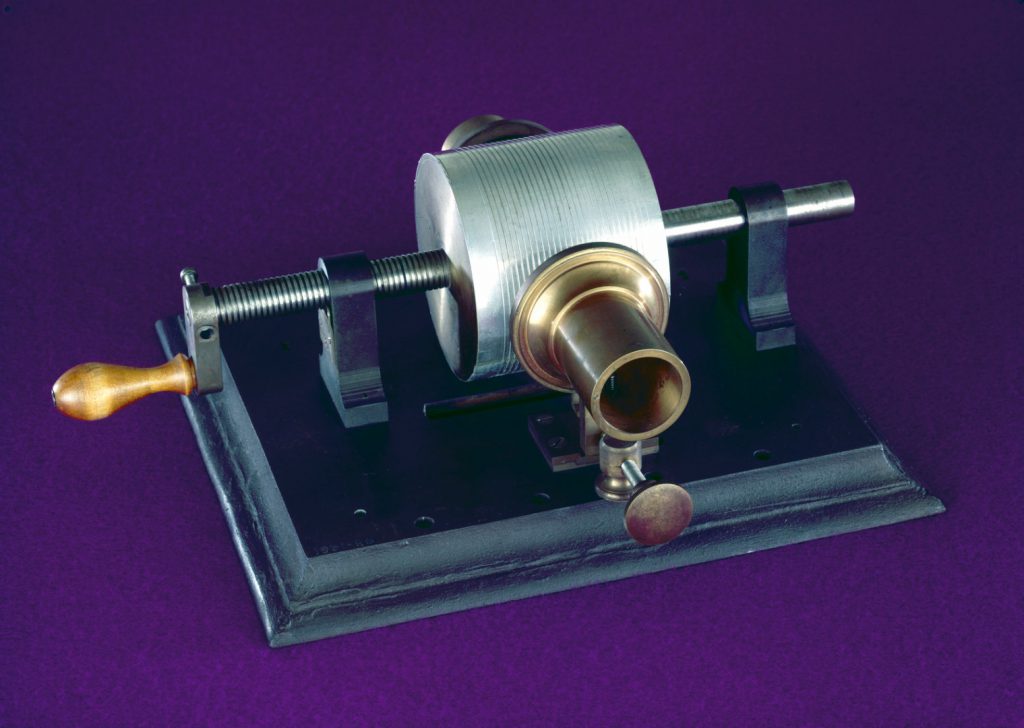
The Bell Report made several recommendations for the modernisation of the Science Museum, including new buildings and new strategies for the acquisition, categorisation and display of collections. Administrative problems and a World War stymied the new building work and it was not until 1925 that the acoustics collection was relocated to the Museum’s new East Block. Keeper of Physics, Ernest Lancaster-Jones, interpreted this deferral in modernisation not as a hindrance, however, but as an opportunity for reviewing the acoustics collection and for thinking carefully about a rationale for its future development. In 1923, Lancaster-Jones completed a new scheme for the expansion of the collection. The scheme subdivided the collection into five discrete sections corresponding to the production, control, recording and measurement of sound, and to the application of acoustics in science, technology and industry. An additional section, called the ‘Index Collection’ included diagrams, photographs, models and a large written label, and highlighted important stages in the development of these various branches of acoustics.[5] This new taxonomy transformed the acoustics collection both physically and discursively, embodying the approaches to museum display set out by the Bell Report and later standardised by Sir Henry Lyons, Science Museum Director from 1920 to 1933. The categorisation of objects also meant that critical questions were now being asked in order to define disciplinary boundaries, to develop a rationale for the acquisition of new objects and, importantly, to assess strategies for displaying the collection to the public.
In the months leading up to the official opening of the Science Museum’s East Block in March 1928, Lancaster-Jones worked closely with industry in order to bring the Sound Receivers, Recorders and Reproducers section up-to-date. The Gramophone Company – then market leaders in Britain in the development of the gramophone – made a substantial contribution in the form of several object loans. Combined with existing Science Museum acquisitions, the objects were abundant enough to chart the principle developments in phonograph and gramophone technology from the 1870s to the present.[6] [7] Historical objects from the Gramophone Company’s museum in Hayes included Stoh’s experimental sound reproducer made in 1878; a set of early Edison sound boxes; and a gramophone with an inverted horn made in 1910. Two instruments, both produced by the Gramophone Company, represented the pinnacle of modern gramophone technology: the first an automatic 20-deck gramophone, the second a state-of-the-art electric gramophone.[8] Following the advice from the Bell Report, which had advocated the instructive possibilities for public demonstrations of the Museum’s objects, Lancaster-Jones recommended that these two ‘striking developments’ be made audible to visitors (Follett, 1978).[9]
For Lancaster-Jones, the instructive potential of the demonstration of the electric gramophone lay in its ability to showcase the effects of technology upon sound propagation and sonic particularity, attributes that, he felt, language could not adequately capture alone. Referencing an existing demonstration in which the same music record was played consecutively on a pre-war, a post-war and an electrical instrument, he wrote that acoustic display ‘does more to express the great development in the technique of reproduction than any amount of verbal explanation’.[10] Through attentive listening, an appreciation of the technical attributes of modern gramophone technology would necessarily follow. Furthermore, as the reference to the existing demonstration illustrates, the electric gramophone offered an auditory equivalent to the taxonomic approach to museum display, which encouraged appreciation of technological development through direct comparison. The demonstration showcased the height of sound reproduction technology against which reproduced sounds encountered outside the museum might be measured.
A gramophone demonstration
https://dx.doi.org/10.15180/170706/003In March 1928, in the weeks leading up to the Royal opening of the East Block, the electric gramophone was mounted onto a platform overlooking the cavernous hall of the Museum’s new building. An accompanying amplifier and set of loud speakers, in addition to the prominent if precarious position of the gramophone, meant that the sound demonstration would be audible to visitors across the Museum. The demonstration was featured at the opening and thereafter as part of the daily lecture service, when at scheduled intervals the electric gramophone transformed the usually silent spaces of the Museum (Follett, 1978).[11] These were popular demonstrations with visitors coming to the Science Museum especially to tune-in to the popular overtures, symphonies and concertos, played on records also supplied by the Gramophone Company (Follett, 1978).[12] [13] Quiet contemplation of these records was not, however, the position taken by all visitors all of the time.
An order issued in 1929 hinted at the way in which sound demonstrations elicited a kind of behaviour potentially out of place at the Science Museum:
In the event of the conduct of visitors becoming unruly in the vicinity of the gramophone and wireless demonstrations, the attendant in charge will terminate the demonstration at once.
Follett, 1978, p 153
The order represents an unintended consequence of the gramophone demonstration, which was to disrupt the codes of conduct associated with the spaces of a national museum. The nature of visitors’ ‘unruly’ behaviour is unclear, though the very existence of the order suggests that gramophone sounds might have been appreciated by visitors less for their capacity for instruction and more for their associations with popular and collective forms of entertainment. The unruly listening body – potentially mobile, potentially vocal – threatened to unmoor the silent and detached observing body governed by mundane museum technologies like the glass and mahogany showcase and the written object label.
The daily demonstration of the electric gramophone continued throughout the interwar years. The Gramophone Company visited the Museum regularly to service the demonstration machines, replacing older machines with newer models in order to showcase the most recent developments in industry.[14] Yet Museum staff continued to highlight the disruption caused by the demonstrations, which occasionally gave rise to unruly behaviour and tended to annoy visitors in adjacent sections.[15]
One solution to was to play around with the positioning of speakers in order to combat the high level of reverberation caused by the architectural acoustics of the galleries.[16] Another was to remove the demonstrations entirely and to relocate them to a purposefully built soundproof room. Following the re-opening of the Museum after the Second World War, the demonstrations of the electric gramophone were re-located to the lecture theatre so that, according to the annual report of 1950, ‘visitors may listen in comfort under the best conditions possible in the museum’.[17] Indeed, the soundproof space of the lecture theatre helped retain the sonic particularities associated with electric gramophone technology, and prevented sound from spilling into spaces for which it was not meant. But it also provided a technique for developing a kind of listening conduct fit for purpose in the modern museum. The lecture theatre offered a formal space for attentive listening where listeners could see the source of sound before them from the comfort of their seats, which themselves held bodies firmly in place. This combination of looking and listening from a distance offered an auditory equivalent, therefore, to the Museum’s established economies of seeing, embodied through technologies like the glass and mahogany showcase. The lecture theatre represented a technology for containing sound and for disciplining conduct, thereby reinstating the disciplined and detached observing body fitting for a national museum.
In 1952, the ‘Electric Gramophone Recitals’ were brought to a close. According to the Science Museum’s annual reports, the demonstrations declined in popularity with many visitors now attuned to modern gramophone sounds through their everyday domestic listening practices. Furthermore, museum assistants, already in short supply, were required elsewhere for the daily demonstrations of the recently renovated auxetophone, pyrophone and tinfoil phonograph.[18] Persistent, however, was a belief in the instructive potential of the auditory in displaying the sound recording and reproduction collection, which continued to expand to keep pace with the rapid developments in acoustic technology characteristic of the 1950s and 60s. As sound was enrolled once more as part of a state-sponsored experiment into acoustic guidance in the 1960s, staff would again encounter the tension between possibilities of sound for acoustic display and the role of sound, and sound citizenship, in shaping the cultural politics of the Science Museum.
The Radio-Guided Tour
https://dx.doi.org/10.15180/170706/004In 1958, the arrival of a new Assistant Keeper of Physics prompted a second major reassessment of the acoustics collection and with it further meditations on the role of sound in displaying the acoustics collection. Almost immediately after his employment by the Science Museum, (Victor) Kenneth Chew set about devising a new scheme for the development of the acoustics collection. Chew’s new tenure coincided with a rapid period of modernisation at the Science Museum, particularly in the arts of museum display. For the first time collections had become too large to be housed on the Museum floor in their entirety, leaving keepers with the need to make choices regarding which instruments and objects to display and which to place in storage out of public view. As Chew pondered ways to develop and display the acoustics collection in 1958, a handful of gallery spaces in the Museum were being transformed by new approaches in the arts of visual display. The new Electric Power and Iron and Steel galleries, for example, exemplified new narrative-based approaches, replacing formal grid-like arrangements of glass and mahogany showcases with an exhibition landscape based upon the principles of contrast in scale, texture and colour. Perceiving himself ‘not yet sufficiently acquainted with contemporary methods of display’ and believing that he did not possess the talent for visual display shown by his colleagues, Chew suggested the recruitment of an external artist to execute his plans. His proposal was promptly rejected and Chew was tasked with developing a new scheme for displaying the sound recording and reproduction collection alone. The result was an exhibition scheme attentive to both sight and sound, which demonstrated a curatorial imagination as creative and ambitious as that of his Science Museum contemporaries.

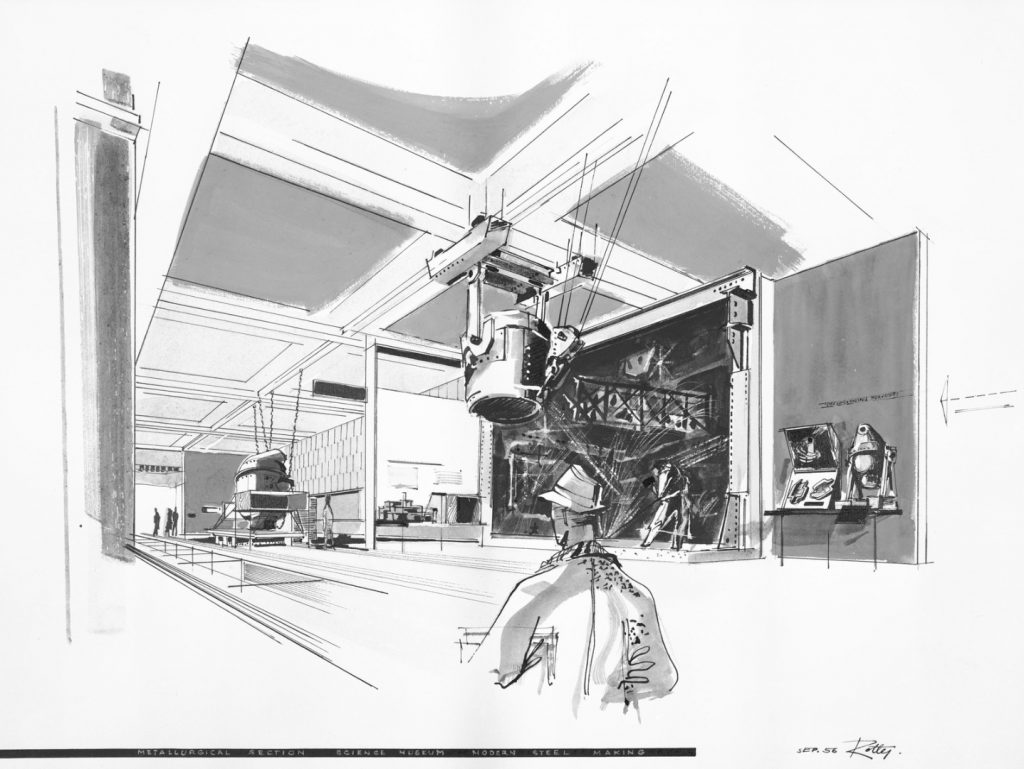
A key component of Chew’s proposal for the development of the acoustics section was a so-called ‘audition room’, a small soundproof space for the demonstration of both modern and historic examples of sound recording and reproduction technology.[19] According to its plans, Chew’s audition room would house approximately twenty listeners. Its external walls would be made of glass to allow the instruments to be seen even when not in use. For those inside the audition room, a curtain would screen off the outside world, conjuring an intimate space redolent of the private listening spaces of the home. The instruments and accompanying sounds would together make up a timeline of the history of sound recording and reproduction, thereby mobilising an auditory taxonomy which would cultivate the expert ear through direct contrast and comparison of sounds and sound technology. Further, the design of the room – a dedicated space for listening, as well as for looking – actively encouraged visitors to engage with sounds and music emotionally, hinting at the phonograph and gramophone’s capacity for entertainment. Lack of funds, and the possible infringement of Museum policy, which discouraged industry sponsorship whether monetary or in the form of object loans, meant the audition room never made it beyond the planning stage and it would be several years before Chew would be given the opportunity of developing a sound installation based upon similar principles.
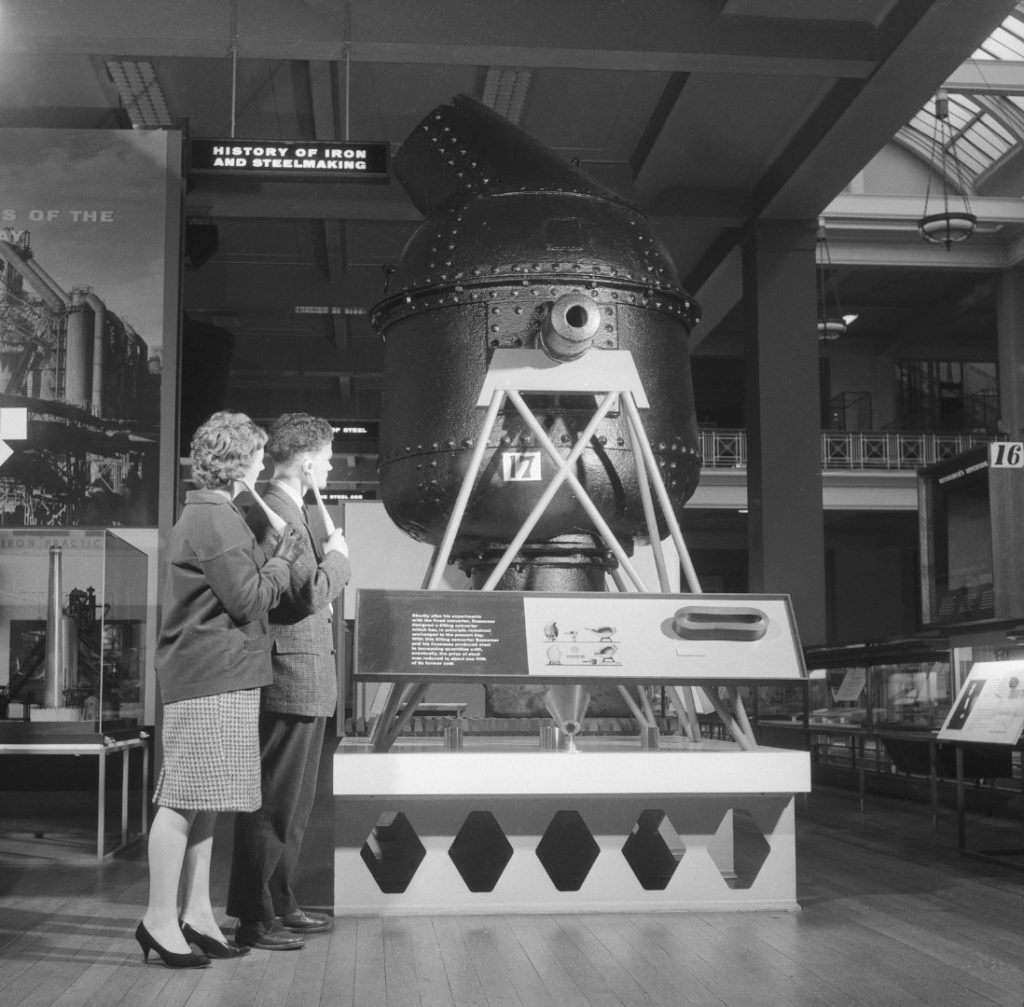
In 1960, the Science Museum – taking advantage of a state-sponsored experiment into the use of acoustic guidance in national museums and galleries – introduced a new technology for audio interpretation known as the Radio-Guided Tour. The experiment had initially been proposed by the Ministry of Works, which promised to extend the scheme to other publicly owned national museums, subject to successful trials. With an in-house workshop ready to respond to technical failures and as an experiment into applied science in its own right, the Science Museum was the obvious host for the Radio-Guided Tour experiment. The technology comprised of a miniature radio station which broadcast a taped commentary via a loop induction system to a series of hand-held radio receivers. The radio receivers, known colloquially as ‘lorgnettes’, were made available for hire at the Museum’s bookstall at a cost of one shilling and a returnable deposit of ten shillings (see Figure 5). The first exhibition space to host the scheme was the recently opened Iron and Steel Gallery, followed by Electric Power, Sailing Ships and the Acoustics Gallery just three months later. The Radio-Guided Tour for Iron and Steel steered listeners through a new exhibition landscape – the product of a substantial grant from industry – and to a series of star objects that together retold the history of iron and steel from prehistory to present.[20] The Radio-Guided Tour for Electric Power took the form of a mock-guided tour with cast comprising of Museum Assistant John Smart playing fictional museum guide and real-life Guide Lecturer, John van Riemsdijk, and his wife playing the roles of ordinary visitors. In Sailing Ships, the Radio-Guided Tour offered a narrative thread connecting objects contained in the glass showcases, constrained within older, rigid and rectilinear techniques of museum display. For Acoustics, the utility of the Radio-Guided Tour was perhaps most obvious, enabling listeners to hear from a small selection of acoustic instruments on display.
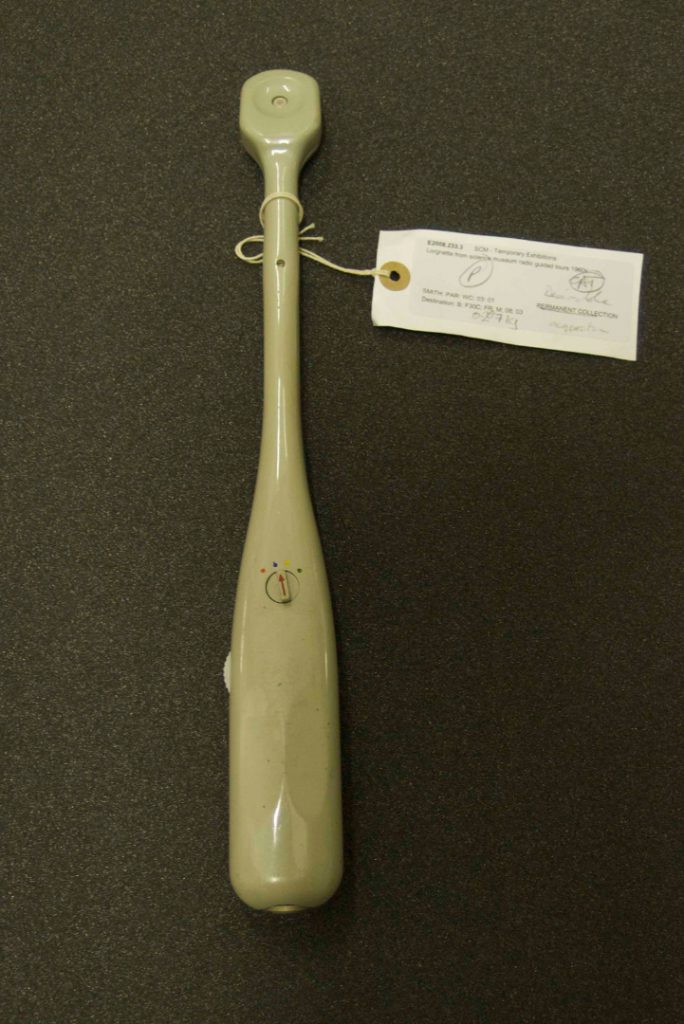
For Chew, static and soundless modes of displaying the acoustics collection failed to communicate the technological and cultural significance of individual acoustic objects. Reviewing the possibilities of acoustic guidance in 1964, Chew remarked how the Museum visitor ‘cannot properly appreciate the Pyrophone, the Musical Glasses, the Bell-Ringing Machine and the Edison Tinfoil Phonograph unless they are given the opportunity of hearing what they sound like’.[21] Echoing the earlier acoustic demonstrations of the electric gramophone in the soundproof spaces of the new lecture theatre, the Radio-Guided Tour aimed at cultivating the expert ear by combining the practices of looking and listening. Like Chew’s audition room, too, the Radio-Guided Tour carved out a dedicated space for listening between handset and ear so as to maintain the relative quietude of the Museum. The technology allowed Chew to harness both the instructive potential of sound as an index of technological particularity and the performative potential of sound as a carrier of cultural meaning and significance whilst, in principle at least, avoiding its spillage into other parts of the Museum. In reality the four commentaries, which were broadcast on four different frequencies, tended to clash with one another. Snippets of the commentary for Iron and Steel, for example, could occasionally be heard in Sailing Ships. Furthermore, the rise of portable tape players and the on-going acquisition of objects for the collection, meant that the Radio-Guided Tours quickly became obsolete. Persistent technological failures and the tendency of visitors, whether by accident or by design, to steal their radio receiver added further weight to arguments which called for the removal the Radio-Guided Tours from all four galleries just four years after their launch.
In 1964, after the Acoustics Gallery once again fell silent, Chew paused to reflect on the future of acoustic guidance across the whole Museum. He questioned the usefulness of the scheme as a tool for instruction and doubted whether the Radio-Guided Tour did anything more than simply demonstrate that the Museum was ‘moving with the times’.[22] The Museum’s Director, David Follett, also questioned the appropriateness of the scheme within a national museum:
The fundamental question is whether these systems are really useful and genuinely appreciated by the visitor, or whether they are really no more than gimmicks which give a spurious aim of modernity, or ‘being with it’[23]
These comments highlight the contested nature of sound in the Museum, as well as the place of certain sound technologies that point towards popular listening cultures outside the Museum. Follett’s comments also point towards the kind of conduct deemed fitting for a national museum and the anxiety felt by some staff concerning the potential of sound to disrupt the established visual methods through which knowledge and visitor conduct is governed. Like the demonstration of the electric gramophone, the Radio-Guided Tour experiment highlights both the practicalities and politics of using sound in the process of putting acoustics on display. Both represent attempts to ask sound to conform to visual methods and technologies through the compartmentalisation of sound and listening practice. The third and final encounter with acoustic display represents a conscious disruption of the established economies of seeing at the Science Museum. It marks an experiment into the possibilities of sound as a sense-making tool freed from visual regimes that govern of knowledge and conduct in the museum.
The Trumpet Shall Sound
https://dx.doi.org/10.15180/170706/005In December 1977, actress and opera singer Janet Baker unveiled a temporary exhibition at the Science Museum.[24] So named due to the large volume of horns displayed, The Trumpet Shall Sound commemorated one hundred years since the invention of Thomas Edison’s tinfoil phonograph. Given pride of place in the Main Hall, the exhibition took the form of an installation shaped like an attic, with accompanying sloping roof, tiles and ceiling joists, evoking the manner in which a collector might store his or her vintage objects. Visitors entered by ascending a set of small steps. Once inside, each would then progress along a narrow walkway through five small rooms, gazing at the one hundred and twenty phonographs and gramophones placed behind a Perspex screen, some on the floor, others propped on top of old suitcases. A series of historic advertisements decorated the attic’s gable ends, giving commercial and cultural context to this rare grouping of objects commemorating the golden age of the talking machine.[25]
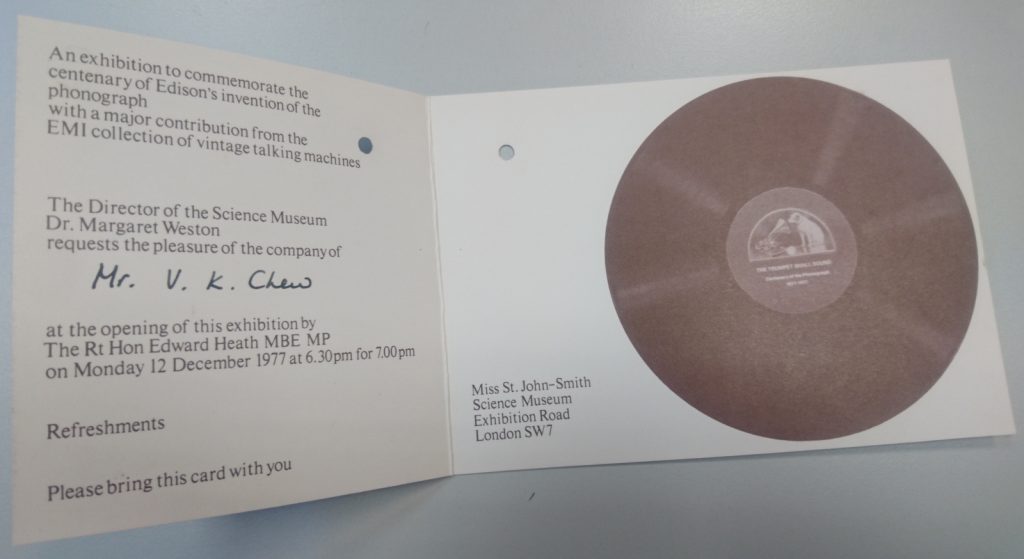
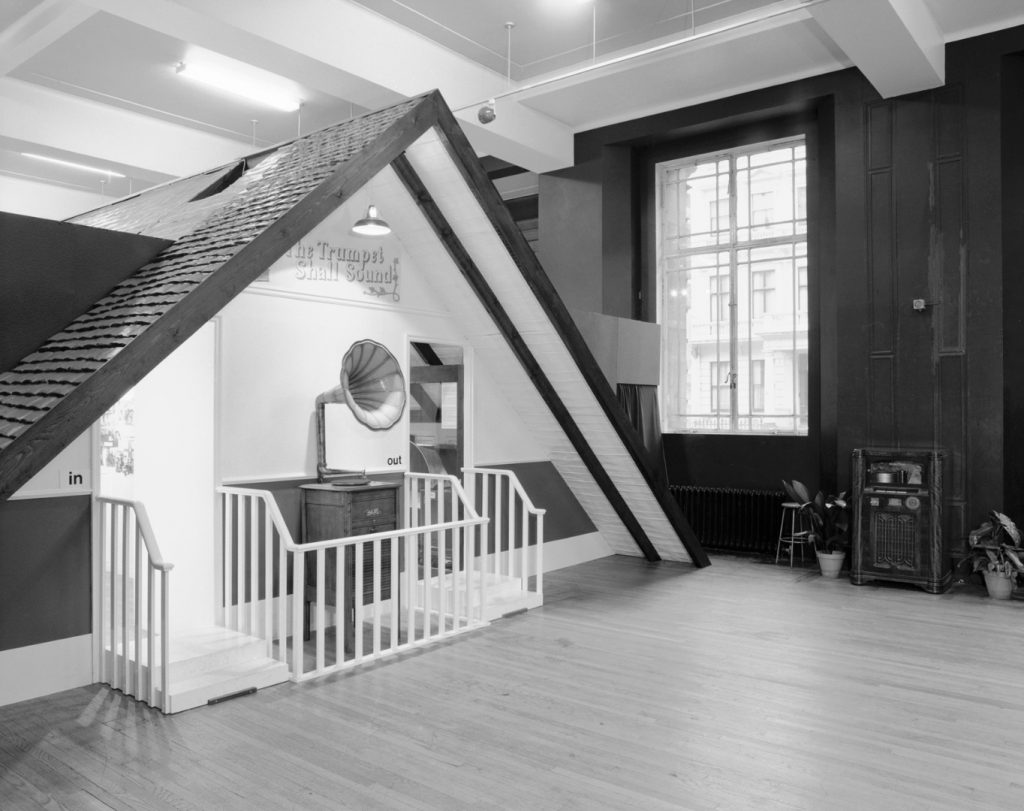
The Trumpet Shall Sound was self-consciously nostalgic, celebrating the historic range of instruments on display. In 1974, the Museum had acquired, on loan, a large volume of phonographs and gramophones from EMI’s museum in Hayes. The objects ranged in date of manufacture from 1878 to 1938 and thus fell broadly within the critical years of the technological development of the phonograph and gramophone. The EMI collection made up the majority of the objects in the exhibition. Additional instruments from the Science Museum collection emphasised the significance of Edison’s role in the story of talking machines.
The Trumpet Shall Sound provided Chew with an opportunity to experiment with acoustic display in the interpretation of what he referred to in the Science Museum’s annual report in 1977 as the ‘Cinderella collection’. The centenary of the tinfoil phonograph provided Chew with a rare opportunity to experiment with exhibition techniques hitherto associated with larger exhibitions such as the Shipping Gallery, which gave visitors the impression of being aboard a real ship, and the Aeronautics Gallery, which put visitors within a full-scale simulated aeroplane hangar. Chew could now abandon, albeit temporarily, rows of glass showcases housing objects with verbose written labels to make way for a new exhibition landscape which used spectacle and humour, performance and play, in order to capture the attention of his visitors. The occasion also offered Chew an opportunity to return to sound in the practice of putting the sound recording and reproduction collection on display. A key component of the installation was a taped commentary, both written and recorded by Chew, which represented a serious attempt at positioning sound as a key carrier of the exhibition’s meaning and narrative.
Broadcast on a set of loudspeakers, the audio accompaniment comprised verbal descriptions of select objects, supplemented by a series of audio excerpts from relevant historic records. Each description included a number enunciated by Chew twice, enabling listeners to link the commentary to the particular object in question. The numbering system corresponded to that used for an EMI catalogue produced for the EMI museum in Hayes in 1974, which had been written by the editor of the magazine Talking Machines Review, Ernie Bayly. A second edition of the catalogue was published in December 1977, copies of which were available for purchase in Science Museum’s bookshop for the duration of the exhibition.
The sound commentary was divided into five sections, mirroring the structure of Chew’s text on the history of the phonograph and gramophone, ‘Talking machines 1877–1914: some aspects of the early history of the gramophone’, published in 1967. The first section celebrated Edison’s contribution to the talking machine industry and spoke of the contrasting uses of the phonograph as an office dictating machine, as an instrument for entertainment and as a tool for research into the scientific study of acoustics. The second section turned attention to the Berliner company in Germany and the exploitation of Berliner machines in Britain by The Gramophone Company. The third dealt with developments in gramophone technology in both France and Germany. The fourth and fifth sections dealt with portable and toy machines, and what Chew referred to as ‘freaks’, so named either for their idiosyncratic design or for their technological particularity or obsolescence.
The sound commentary for The Trumpet Shall Sound (excerpts below) was designed to entertain as much as to educate listeners. The historic records and accompanying descriptions went beyond technical detail, aiming to capture, in sound, both the commercial and cultural significance of the phonograph and gramophone in question. An historic recording of a choir of four thousand voices singing the Christmas carol ‘Oh Come All Ye Faithful’ aimed to impress upon visitors the capabilities for fidelity of the electrically recorded disc produced in 1925.[26] A recording, obtained from the BBC’s archives, of Lord Tennyson’s reading of his poem ‘The Charge of the Light Brigade’ spoke to the phonograph as an instrument for the preservation of the sounds of national identity.[27] An excerpt from the First World War hit song ‘Pack Up Your Troubles’ introduced a section on the portable gramophone. Here Chew guided the attention of listeners towards a portable Decca gramophone manufactured in 1914 with outer casing decorated with twelve battle honours. The coupling of sight and sound aimed at harnessing the emotions as a sense-making tool. The sight of the portable Decca gramophone, hundreds of which were used to entertain troops sent to the trenches during the First World War, coupled with this popular war song, captured the permeation of everyday collective listening practices into the extraordinary soundscapes of warfare.[28]
The commemorative celebrations of Edison’s tinfoil phonograph provided a rare opportunity for gathering together not just a set of star items from the golden age of the talking machine, but a set of star sound objects too. The sonic excerpts that made up Chew’s sound commentary represented an integral part of the exhibition, providing information on specific objects, offering points of departure for the elucidation of historical and cultural context, and conjuring the appropriate emotions and sensibilities fitting for the exhibition’s overarching theme. Chew’s sound commentary filled the installation, placing sound at the forefront of the exhibition’s design. The visual components of the display acted as a backdrop to foreground sounds and spoken word, prompting a reversal of the established hierarchy of the senses embedded in display practices at the Science Museum at that time. Attic sounds thus displaced the figure of the detached and static observer and forged connections between visitor and the objects on display, activating participation in the mobilisation of the exhibition’s meanings and narratives.
The Trumpet Shall Sound received extensive coverage in The Hillandale News – the official publication of the City of London Phonograph and Gramophone Society – which celebrated its one-hundredth edition in 1977. Four society members reviewed the exhibition, though each took issue with the style of display, regarding the attic installation as an undignified stage for these rare collector’s items. ‘Poor show – three out of ten’, remarked one, whilst another spoke of the difficulty in finding ‘any good words to say about the exhibition’ at all. Criticism hinged on the tight grouping of objects, many of which were pushed back in the shadowy recesses of the attic’s eaves. One reviewer, for example, spoke of having to kneel on the floor in order to study a series of Spanish replicas of an Edison phonograph. Though one spoke of the pleasure of hearing Chew’s familiar voice, comments largely focused on the exhibition’s visual design with little scrutiny given over to the its auditory features. Such visual bias may indicate a pre-existing knowledge in this expert audience of the technical details and historical anecdotes recounted in the exhibition, but it also hints at the absence of a discourse through which to articulate the effects of sound and the sound installation as technologies in shaping the museum-going experience. Kneeling on the floor, straining to catch a glimpse of a phonograph or gramophone, suggest an on-going adherence to established sensory hierarchies embedded in museum exhibition practice which, at the Science Museum at least, continued to privilege the eye over the ear.[29] Chew’s serious attempt at reversing the hierarchies of the senses via the technologies of the sound installation seemed, for some at least, to fall on deaf ears.[30]
Following The Trumpet Shall Sound exhibition, the Science Museum purchased several objects from the EMI collection, which had been put up for auction at Christie’s in London. The new acquisitions were added to what Chew in 1978 re-titled the ‘Talking Machines Gallery’, which reunited a set of objects that had been dispersed across the Museum following building work in the East Block in 1976.[31] The new Talking Machines Gallery took broadly the form of its early 1970s predecessor, configured through traditional and visual forms of display. This collection was displayed through a set of techniques that returned the figure of the detached observer with sound once again reserved for scheduled demonstrations. In 1978 Chew retired from his post as Keeper of Physics. During the 1980s a permanent exhibition on Optics replaced the Talking Machines Gallery whose objects were either placed in storage or recruited to play parts in exhibition narratives in other parts of the Museum.
Conclusion
https://dx.doi.org/10.15180/170706/006This article has traced sound as it has echoed through approaches to displaying the sound recording and reproduction collection at the Science Museum from the 1920s to the 1970s. Specifically, this article has teased out the characteristic failure of sound to provide an appropriate and meaningful medium for the interpretation of acoustic objects. It is a failure that, as this article has argued, derives from the unwillingness of sound to conform to visual regimes of governing knowledge and conduct in the museum. The first moment, which explored scheduled demonstrations of the electric gramophone in the 1920s and again in the immediate post-war years, highlighted attempts to compartmentalise sound and to govern listening conducts through the technologies of the lecture theatre, which in turn reproduced the figure of the detached, silent and static observer as that fitting for a national museum.
The second moment, which looked at the Radio-Guided Tour installed at the Science Museum in the 1960s, similarly represented attempts to harness sound’s instructive potential whilst compartmentalising sound and sonic conduct so as to maintain the museum’s characteristic quietude. Failure here corresponded to blatant technological failures, but also the belief of some staff that sound represented a transgression of Museum practice into the realm of entertainment as embodied in the figure of the listener, ear pressed to hand-held receiver, which represented an intrusion of popular culture into a serious space for learning. The third and final moment marked an attempt at freeing sound from the constraints of the visual via the technologies of sound installation. The attic space of The Trumpet Shall Sound exhibition allowed (Victor) Kenneth Chew, to exhibit a set of sounds as objects which provided a visual backdrop to a set of foreground sonic excerpts. That reviews criticised the exhibition due to the poor visibility of objects suggests that sound failed as an effective carrier of meaning due to a cleaving, on behalf of some visitors, to visual modes of navigating and knowing the Museum.
Thinking historically, this article has retrieved a body of knowledge and practical expertise, giving new purpose to past experience and experimentation as resources for those thinking about acoustics as both medium and as object for museum display. In moments of negotiation on the place of sound and sonic conduct at the Science Museum, this article has seen reflections on the practice of putting acoustics on display at their most articulate. Exploring the traces of sound experimentation at the Science Museum, this article has provided a corrective to museum studies literature which has regarded acoustic modes of display as something new associated with museum practice emerging from the sensory turn in the humanities. This is surprising given the place of acoustic exhibits in the histories of a wide range of museums at local and national scales. This article has demonstrated how the custodians and curators of acoustics collections offer a potentially rich repository of ideas, of both successes and failures, which can support modern museum practitioners in developing a vocabulary for dealing with sound in the museum, a vocabulary attentive to the possibilities of sound to reorganise the dissemination of information in the museum in new, critical and creative ways.
Acknowledgments
The author would like to thank the AHRC for funding the research on which this article is based. Thanks to James Mansell and Tim Boon for their on-going encouragement and valuable feedback as the project and writing progressed. Thanks also to John Liffen for sharing his inimitable knowledge of the acoustics collection during the author’s many visits to the Science Museum’s archive and store, and to three anonymous reviewers for their generous and constructive comments.
Footnotes
Back to text
Back to text
Back to text
Back to text
Back to text
Back to text
Back to text
Back to text
Back to text
Back to text
Back to text
Back to text
Back to text
Back to text
Back to text
Back to text
Back to text
Back to text
Back to text
Back to text
Back to text
Back to text
Back to text
Back to text
Back to text
Back to text
Back to text
Back to text
Back to text


